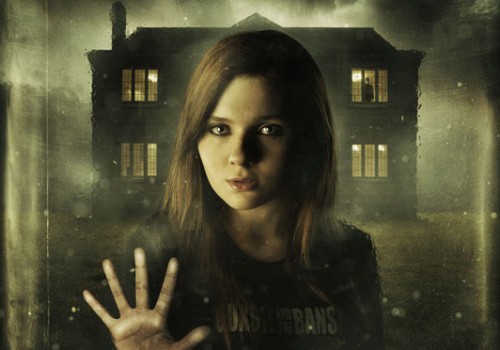
Written by Mychael Blinde.
In Haunter, Abigail Breslin plays a teenager who galvanizes a team of young women to challenge their evil oppressor together! Oh, and they’re all dead.
Haunter (2013) is a scary – and yet feel-good! — teenage-lady-driven horror film. It’s creepy but not gory, and Breslin and her character, Lisa, are both fantastic.

The most recent film by Haunter’s director, Vincenzo Natali, was Splice, a film I very much enjoyed.

Haunter’s horror is very different from the science-driven horror of Splice. In Natali’s words: “I would almost call Haunter ‘fantasmagorica.’ It’s somewhat of a fantasy with darkness lurking around the edges.”

Speaking of films that Haunter is not like, Haunter is not like The Sixth Sense or The Others. In those films, the protaghostnist’s status is revealed as the final twist, whereas in Haunter, we learn relatively early on that Lisa and her family are the dead characters.
We meet Lisa just a few days after she’s discovered that she, her mother, her brother, and her father are all stuck reliving the same Sunday over and over again, trapped in their house by a thick fog that distorts space and prevents escape.

Not that Lisa’s family is remotely interested in escape – they seem blissfully unaware of the daily repetition and express concern for Lisa when she tries to explain it to them.

Lisa is frustrated with her family’s denseness, and also alarmed to discover strange and creepy things happening around the house… and she keeps hearing someone whisper her name.
Then an evil presence intrudes on her family in the guise of a telephone repairman. This character is named Edgar Mullins, but actor Stephen McHattie is credited as The Pale Man.

The Pale Man confirms what we, the audience, already suspected: this repeated Sunday – the day before Lisa’s 16th birthday – is her death day. Lisa is the ghost, and the voice she’s hearing is from the world of the living.
The Pale Man warns her: “If you should try to contact the living, or anyone else, you and your family will suffer in ways you cannot fathom.” But Lisa figures out that the living are already suffering, and that she’s been summoned by the living teenager in the house, Olivia, who is seeking Lisa’s help.

Lisa proves herself to be a smart, brave, and determined protagonist. She sends out a message to all of the Pale Man’s victims: “We can send this bastard to hell, but we have to do it together.”
And sure enough, she teams up with Olivia and with all the other young lady ghosts killed by the Pale Man’s evil, and together they vanquish him! Lisa restores order and peace to both life AND the afterlife.

This is a wonderful exception to film after film after film after film of male characters saving the day. It’s especially nice to see a teenage girl not only carry this movie, but succeed as the hero, and to see so many female characters join together to defeat their oppressor.
By making Lisa and her family ghosts and cluing the viewer into their ghost-status early in the film, Haunter sidesteps the most pervasive problem in haunted house films: the JUST GET THE FUCK OUT OF THE HOUSE problem. (I mean, REALLY, why did they even move there in the first place?!)
The question Haunter inspires isn’t, “Why don’t they just leave the house?”
Instead, Haunter asks:
If YOU were stuck in a house reliving the same day over and over, would you risk tangling with powerful forces beyond your control to escape? What if lives are at stake – but you’re dead?

I wanted to find a horror movie to do that was really smart and unique and different. And when I read this, I thought it was really exciting. I loved the character and the story—and it took me like three reads before I truly figured out what was going on. I love that you can’t really call the shots. It’s not really your typical horror flick. I love supernatural stories—demons and ghosts…I want the suspense, the spine-tingle, the story you’re trying to unravel.
Haunter does get a little confusing at times, primarily because the house exists in one physical space and yet on different planes of existence:
Even though the film takes place entirely in this house, the house is in itself a kind of universe. It’s a universe composed of various strata of different time periods and I loved the way the script opened up. We thought we were in one kind of world and then as this thing unravels, we realize that it’s something much larger than that.
I think this overlapping of worlds and women was an interesting idea to explore, and worth the minor confusion. The overlapping timeframes allow these young women to work together to overthrow the malevolent Pale Man.
Sure, he might be scary…
…but she’s scarier!

I read Haunter as a film about the triumph of teamwork against a tyrannical patriarchy.
The film is driven by the fear of male control and aggression, fear of men’s anger and their capacity for violence. The Pale Man kills by inspiring a murderous rage in the husband/father figure, which results in the death of the entire family.

Here’s how Natali describes the Pale Man:
He is the Minotaur in the maze. Or the spider in the center of the web. He is the manipulator. He’s that thing you don’t see, but you know is there and waiting for you.
He is the patriarchy: he enforces an invisible oppression through the systemic subjugation of women. Then a brave young woman overcomes her subjugation and inspires a group of women to join forces, to create a new and better world for the living and the dead alike.
________________________________________________________________________________
Mychael Blinde writes about representations of gender in popular culture at Vagina Dentwata.


